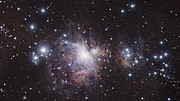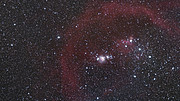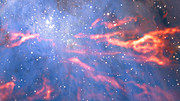ALMA Reveals Inner Web of Stellar Nursery
The jewel in Orion’s sword
Videos
New data from the Atacama Large
Millimeter/submillimeter Array (ALMA) and other telescopes have been
used to create this stunning image showing a web of filaments in the
Orion Nebula. These features appear red-hot and fiery in this dramatic
picture, but in reality are so cold that astronomers must use telescopes
like ALMA to observe them.
This spectacular and unusual image shows part of the famous Orion Nebula,
a star formation region lying about 1350 light-years from Earth. It
combines a mosaic of millimetre-wavelength images from the Atacama Large Millimeter/submillimeter Array (ALMA) and the IRAM 30-metre telescope, shown in red, with a more familiar infrared view from the HAWK-I instrument on ESO’s Very Large Telescope,
shown in blue. The group of bright blue-white stars at the upper-left
is the Trapezium Cluster — made up of hot young stars that are only a
few million years old.
The wispy, fibre-like structures seen in this large image are long
filaments of cold gas, only visible to telescopes working in the
millimetre wavelength range. They are invisible at both optical and
infrared wavelengths, making ALMA one of the only instruments available
for astronomers to study them. This gas gives rise to newborn stars — it
gradually collapses under the force of its own gravity until it is
sufficiently compressed to form a protostar — the precursor to a star.
The scientists who gathered the data from which this image was
created were studying these filaments to learn more about their
structure and make-up. They used ALMA to look for signatures of diazenylium gas, which makes up part of these structures. Through doing this study, the team managed to identify a network of 55 filaments.
The Orion Nebula is the nearest region of massive star formation to
Earth, and is therefore studied in great detail by astronomers seeking
to better understand how stars
form and evolve in their first few million years. ESO’s telescopes have
observed this interesting region multiple times, and you can learn more
about previous discoveries here, here, and here.
This image combines a total of 296 separate individual datasets from
the ALMA and IRAM telescopes, making it one of the largest
high-resolution mosaics of a star formation region produced so far at
millimetre wavelengths [1].
Notes
[1] Earlier mosaics of Orion at millimetre wavelengths had used single-dish telescopes, such as APEX.
The new observations from ALMA and IRAM use interferometry to combine
the signals from multiple, widely-separated antennas to create images
showing much finer detail.
More Information
ESO is the foremost intergovernmental astronomy organisation in Europe
and the world’s most productive ground-based astronomical observatory by
far. It is supported by 16 countries: Austria, Belgium, Brazil, the
Czech Republic, Denmark, France, Finland, Germany, Italy, the
Netherlands, Poland, Portugal, Spain, Sweden, Switzerland and the United
Kingdom, along with the host state of Chile and by Australia as a
strategic partner. ESO carries out an ambitious programme focused on the
design, construction and operation of powerful ground-based observing
facilities enabling astronomers to make important scientific
discoveries. ESO also plays a leading role in promoting and organising
cooperation in astronomical research. ESO operates three unique
world-class observing sites in Chile: La Silla, Paranal and Chajnantor.
At Paranal, ESO operates the Very Large Telescope and its world-leading
Very Large Telescope Interferometer as well as two survey telescopes,
VISTA working in the infrared and the visible-light VLT Survey
Telescope. ESO is also a major partner in two facilities on Chajnantor,
APEX and ALMA, the largest astronomical project in existence. And on
Cerro Armazones, close to Paranal, ESO is building the 39-metre
Extremely Large Telescope, the ELT, which will become “the world’s
biggest eye on the sky”.
Links
Contact
Alvaro Hacar González
NWO-VENI Fellow – Leiden Observatory
Leiden University, the Netherlands
Email: hacar@strw.leidenuniv.nl
NWO-VENI Fellow – Leiden Observatory
Leiden University, the Netherlands
Email: hacar@strw.leidenuniv.nl
Richard Hook
ESO Public Information Officer
Garching bei München, Germany
Tel: +49 89 3200 6655
Cell: +49 151 1537 3591
Email: rhook@eso.org
ESO Public Information Officer
Garching bei München, Germany
Tel: +49 89 3200 6655
Cell: +49 151 1537 3591
Email: rhook@eso.org
Source: ESO/News




